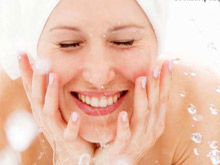 |
The skin is one of the first body parts to show age. While many of these agerelated changes are inevitable, some can be reduced with healthy lifestyle choices and good skin care. Many people even accept that changes to their skin are part of the normal ageing process.
|
Holi is an annual festival of colours, which begins on the day after the full moon in the Hindu calendar, in the month of Phalgun i.e. Feb-March. People celebrate it by applying colours, which can be dry powder, coloured water or in the form of paste. Originally the raw material used to prepare colours was extracted from the available bright flowers and leaves that blossomed during spring. So one could see an array of bright attractive colours from nature. Most of these flowers and leaves were supposed to have medicinal benefits to the skin, when they got rubbed or massaged. Over the years, natural colours have been replaced by less expensive industrial dyes, prepared through chemical processes. It has also become a necessity to fulfill the demand and amount needed. Like other festivals, Holi has also come into the commercialisation trap.
Health problems
As a result, we see a number of health problems during and after Holi. Synthetic colours are responsible for different problems of skin, eyes, hair, respiratory system etc. Common problems are: eczema, erosions, dryness, scaling, redness, urticaria, nail fold inflammation and hair fall.
The colours can also:
1) Exacerbate the existing acne and cause atopic dermatitis, and chronic paronychia
2) Complicate an existing problem as secondary infection or pyoderma of skin
3) Result in ocular complications like redness of eyes, watering, grittiness, itching etc.
4) Result in respiratory problems like rhinitis, throat irritation, bronchospasm (asthma) etc.
Composition and Health Effects
Black: Lead oxide Renal failure, learning difficulties
Green: Copper sulfate Eye allergy, Temporary blindness
Silver: Aluminum bromide Carcinogenic
Red: Mercury sulfate Skin cancer, Neurological toxicity
Purple: Chromium Iodide Bronchial asthma, Allergies.
|
Dry Colours
Dry colours have two components: colourant and base. Both can cause cutaneous problems. Mica is added as a sparkling agent and can cause microtraumas of skin as well as predispose to skin infections. Use of contaminated starch of wheat flour can be other source of infections.
8 Preventive Ways
- Use oil or any moisturising cream before playing Holi.
- Either oil your hair or wear a cap to protect the scalp.
- Loose, white cotton clothes while playing Holi, is a sensible attire.
- If a known asthmatic, avoid dry colours altogether or use mask when applying powder colours.
- After playing, don’t rub paint, powder etc. while removing, as this can be more damaging.
- If the colour or paint is too thick, do not try to get rid of it in one go, otherwise too much rubbing might harm your skin and hair.
- Oil your hair and moisturise your skin before or during bathing.
- Instead of soap, wash with emulsifying shower gel to minimise the irritational and drying effects.
|
 |
Dr. Kuldeep Singh is Senior Consultant in Plastic Surgery Indraprastha Apollo Hospitals New Delhi |
|